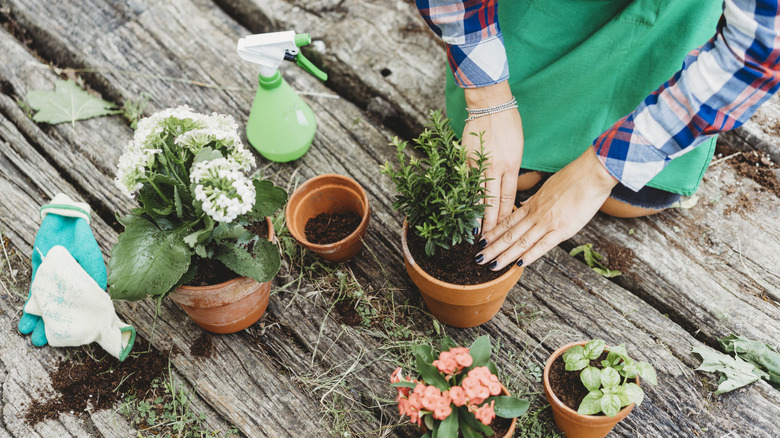How To DIY A Garden Storage Space Without A Shed
Once you start gardening, it doesn't take long before extra pots, seed starting mix, and other must-haves begin to multiply. Without a shed for storage, they can take over your house. However, you don't have to build a durable backyard storage shed to make room for your garden supplies. Instead, you can repurpose things from around your house — or use thrift store and marketplace finds — to create a charming and practical solution that reflects your style and personality. A back porch is the ideal spot for garden storage, but you can also choose any empty spot against the back or side of your house. The best space will be covered so your items don't get wet or damaged.
To begin, pick a good work surface to anchor your space. You can use a potting bench or a repurposed kitchen or dining table. Next, add open shelving above the surface by mounting brackets on the wall and cutting wooden shelf boards to fit. If you're attaching the mounting brackets to vinyl siding, you can use vinyl siding hooks to avoid drilling holes. A cup rail underneath one or more shelves will give you room to hang hand tools or bundles of drying herbs. Hang larger tools such as shovels and hoes from a coat rack or tool rack mounted off to the side of your shelves, and include a rolling cart for movable storage. With the base completed, you can then move onto organizing garden tools so your green thumb can flourish.
How to style and organize your garden storage space
The secret to making a mishmash collection of thrift store and relocated objects look like a designer-quality space is to be intentional. Fortunately, the chipped, rustic, and natural look is a perfect fit for most gardens. A subdued, neutral color palette ties everything together and will cut down the amount of work needed to maintain your space.
Upcycled thrifted baskets are easy to find and mix and match well. Strategically place a few potted plants on your shelves, table, and rolling cart to add aesthetic appeal to an otherwise utilitarian space. Several large, waterproof deck boxes or galvanized steel bins underneath the table can hold potting mix, fertilizer, compost, and other large items. Store fertilizer in its original container with the label in a sealed, dry container and keep it out of direct sunlight. Compost needs airflow to keep beneficial microbes alive, but protect it from water with a loose-fitting lid.
Fill a rolling cart beside the table with watering cans, misters, plant labels, and other necessities. Use your shelves to stack unused terracotta and ceramic pots for easy access. Creating stations for specific jobs will also make it simple to find what you need. Your seed starting station can include your sterile starting mix, a dibble planting tool, and DIY seed starters. If you're designing your own potting mix, you can store each ingredient, such as peat moss, loam soil, and perlite, in airtight bags inside galvanized bins until you're ready to mix them. Tuck smaller plastic containers into your baskets for waterproof storage options that don't detract from the old-world charm.
